Lynx is a Paris-based startup building the Lynx R-1, a standalone mixed reality headset that’s small and lightweight. The headset’s Kickstarter reached its goal 15 hours after launch and is still ongoing, having recently doubled its funding goal. You can pledge for a unit starting at $500.
Cas and Chary VR is a YouTube channel hosted by Netherland-based duo Casandra Vuong and Chary Keijzer who have been documenting their VR journeys since 2016. They share a curated selection of their content with extra insights for the Road to VR audience.
Since they are a startup and have never released a product before, it’s understandable to be cautious about the project. So we reached out to Lynx to ask for a demo and they invited us to come over. In a recent video, we shared our first impressions and showed footage recorded in the headset. In this article, I’ll share a summary of my impressions.
Introduction to the Lynx R-1
Lynx wants to build the world’s most open and versatile device capable of both VR and AR. Not only can you use it standalone, but you can also stream PC VR content or use it tethered with a PC. The Lynx R-1 headset houses six cameras: two B&W cameras for 6DoF positional tracking, two IR cameras for hand-tracking, and two RGB visible light cameras for the color passthrough AR mode. Aside from this, the headset also has a novel lens design that makes it possible to fit it all in a tiny package (compared to current consumer headsets).
Before we dive into my impressions, here are the headset’s full specs:
Lynx R-1 Specs |
|
| Display | 1,600 × 1,600 (2.6MP) per-eye, LCD (2x) |
| Refresh Rate | 90Hz |
| Lenses | Four-fold catadioptric freeform prism |
| Field-of-view (claimed) | 90° diagonal |
| Optical Adjustments | IPD |
| Processor | Snapdragon XR2 |
| RAM | 6GB LPDDR5 |
| Storage | 128GB (up to 1TB via microSD) |
| Wireless | Wi-Fi 6 (802.11ax), Bluetooth 5.0 |
| Connectors | USB Type-C |
| Battery Life | 3 hours |
| Tracking | Inside-out (no external beacons) |
| On-board cameras | 2x B&W, 2x IR, 2x RGB |
| Input | Hand-tracking, controllers |
| Audio | Stereo speakers, 3.5mm TRRS jack |
| Microphone | Yes (2x) |
| Pass-through view | Yes |
When we arrived at the office, it was apparent that it was a startup. The office was relatively small but had a team of about 15 passionate people working on the Lynx R-1 headset. One half of the office had desks where the software was tested, the other half of the room was full of hardware. For example, there was a robot arm that calibrated the display, and pre-production units were assembled by hand. I loved seeing this. I imagined this must have been like when Oculus just started out.
Office Vibes
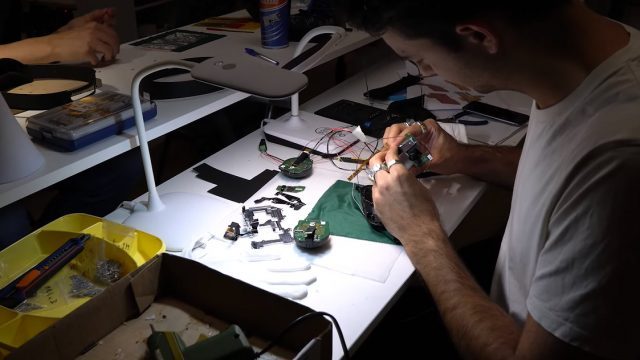
Before the demos, Stan Larroque, the founder, and CEO of Lynx showed us around and he told us that the demo devices were pre-production units that demonstrate basic engineering validations but not yet the experience you’d expect when you buy the headset.
Design & Comfort
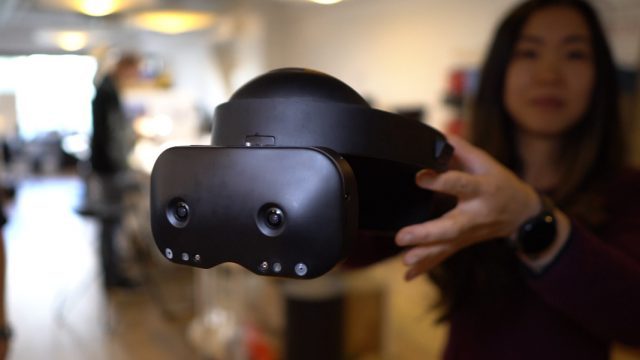
The headset has a small form factor, a lightweight front attached to a ‘halo’ headstrap. The front can be flipped up 90-degrees quickly peeking outside the headset. The forehead holder and backside of the strap have magnetically-attached pads. To balance the front weight, the battery is placed at the back. This design works out well as the headset is one of most comfortable I’ve tried so far.
Novel Lens Design
The headset makes use of what the company calls a “four-fold catadioptric freeform prism” lens. It’s a novel design not seen in other headsets before and this is, according to Lynx, what makes it possible to pack all the components in such a small form factor. You can move these lenses separately to adjust for your IPD.
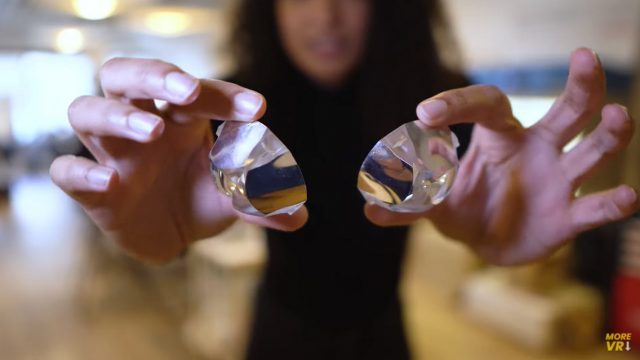
AR + Hand-tracking
The first thing we tried was AR passthrough, which is the primary focus of the headset. The headset is designed to be used this way without any cover on the sides so that you can see as much of the real world as possible (there is a magnetic cover for using the headset in VR mode).
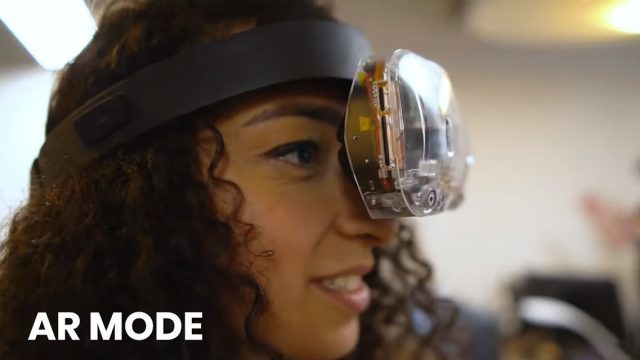
I tried an AR color passthrough demo that showed off the hand tracking. The passthrough had a bit of latency but was low enough for me to comfortably walk around while looking at the passthrough footage. The colors weren’t 100% fine-tuned yet, so sometimes it changed in color temperature but other than that, it worked well.
The hand-tracking is powered by Ultraleap and that’s one of my favorite aspects of the headset as it is very precise and responsive, more so than hand-tracking on Oculus Quest 2. It had no trouble understanding which hand was which, even when my fingers were overlapping (which is a tough challenge for hand-tracking systems). It’s not perfect yet, but I think it’s promising.
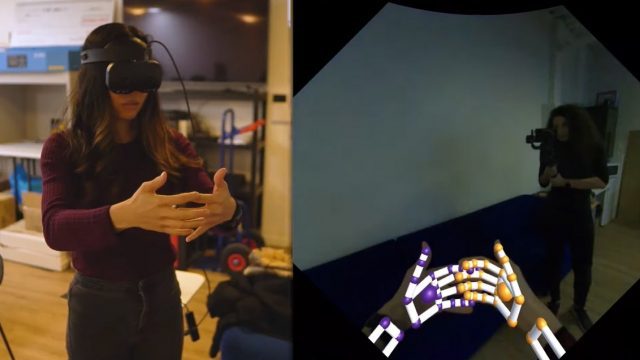
Then I tried another AR app where a solar system was embedded into the real world and I could walk around it, or look at it from a closer distance. While the camera footage of the real world wasn’t as sharp as real life, the solar system looked beautifully sharp.
I was impressed by the AR functionality in combination with the hand tracking. I can imagine the possibilities this opens up for developers.
VR Mode
I’ve tried the Lynx R-1 in VR mode too which employs the ‘immersive cover’ and shows you a purely virtual world instead of passthrough AR. Lynx had a couple of self-developed VR tech demos available, one demo was a Beat Saber clone where I used my hands to slash boxes and another demo which had me casting spells with my hands.
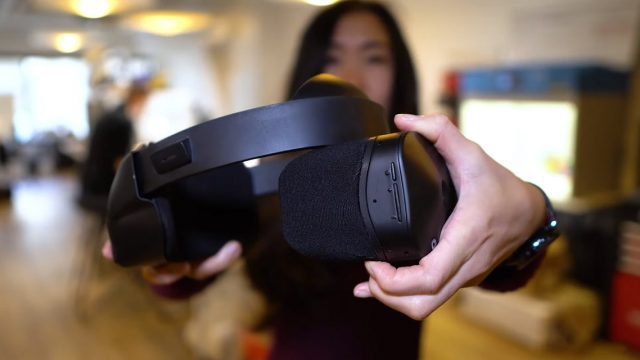
In fully immersive VR mode, it took me a while to get used to the lenses as I needed more time than usual to find the sweet spot and for a couple of moments I found it, but I wasn’t able to keep it. So most of my time in the VR demos I saw something that looked like ghosting because of the lens’ four-fold design that’s corrected by software. Visuals became wobbly around the folding areas. This made it hard for me to judge the display. Strangely, this wasn’t noticeable in AR mode.
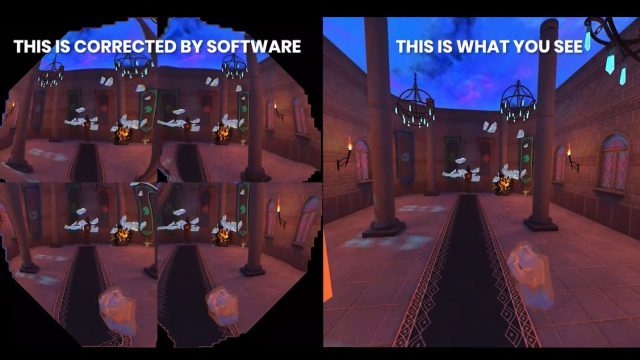
Asking founder Stan Larroque, he told me the lenses and display were not precisely calibrated together in some eyepieces yet, but this should be resolved once they hit production using the tooling of their manufacturer and once the software matures.
Software & Content
The Lynx R-1 is built on Android 10 and will support Unity with an SDK made in collaboration with Qualcomm and Ultraleap. Support for OpenXR is also in the pipeline. Lynx aims to open-source the SDK and make the ecosystem as open as it can. This should make it easy for developers to release games on it.
However, the software is still in its early stages. All the demos shown to me were launched via the command line as there’s no in-VR operating system yet. Lynx says that software is what they’ll be working on from now until release. It will take a few more months but once the software matures, Lynx says it will fix the issues I had during my demos.
Controllers
As for the controllers, Lynx says it will design and manufacture its own. For the tracking technology, it partnered up with FinchShift which designs controllers that can work without any cameras at all as they rely on IMUs for the tracking. Lynx will add the capability of more accurate tracking with the visible light sensors to their own controllers. This wasn’t ready yet, so I couldn’t test it.
– – — – –
While my demos weren’t all issue-free, we did get a good impression of the hardware and company. Lynx’s full transparency is great and it brought me comfort seeing how capable Lynx’s team is. They’ve also made partnerships and are collaborating closely with companies like Qualcomm and Ultraleap, which I think is a good sign. So I think the device is promising, but it is still too early to say if Lynx is on track until we see the hardware and software all come together in the shipping product.
The software will be distributed online as soon as the first units can be sent to developers at the start of 2022. The goal is to start shipping the devices to consumers starting April 2022. If you’re interested in supporting them, check out their Kickstarter.
Disclosure: Lynx sponsored our trip and accommodation. We were not obligated to post a video.







